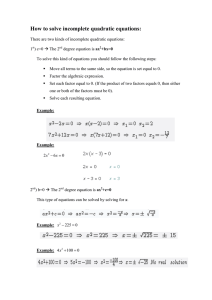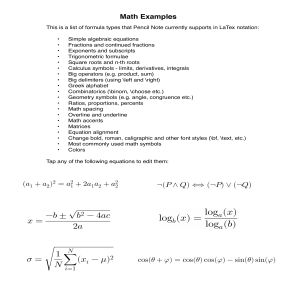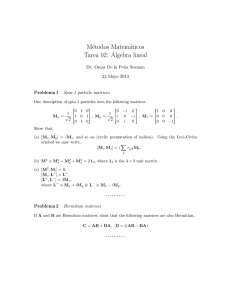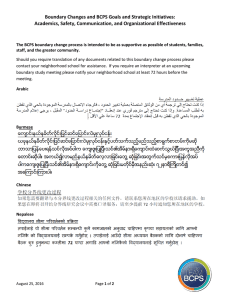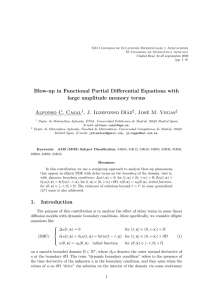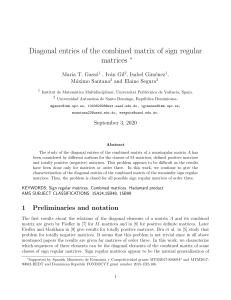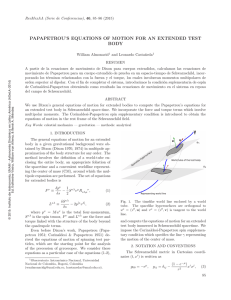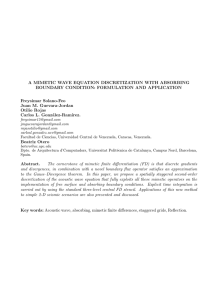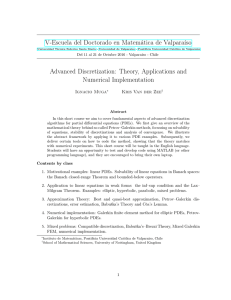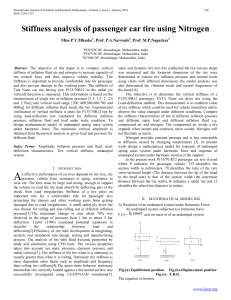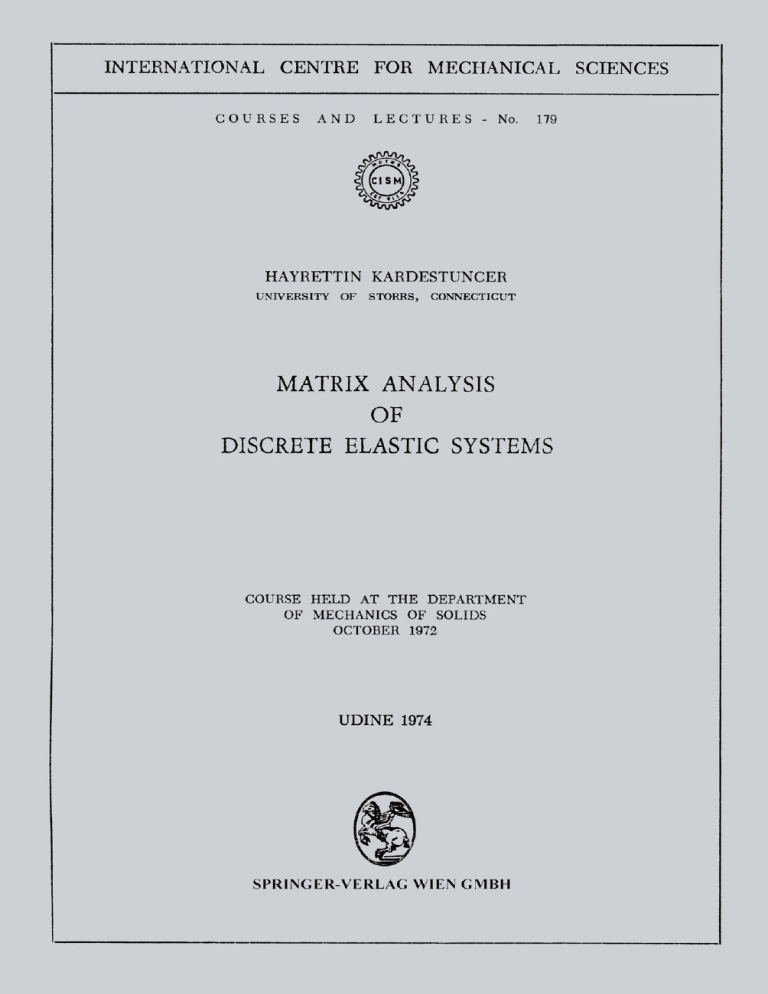
INTERNATIONAL CENTRE FOR MECHANICAL SCIENCES
C0 U RSES
AND
LECTURES - No.
179
HAYRETTIN KARDESTUNCER
UNIVERSITY OF STORRS,
CONNECTICUT
MATRIX ANALYSIS
OF
DISCRETE ELASTIC SYSTEMS
COL"HSE HELD .-\T THE DEPARTMENT
OF MECHANICS OF SOLIDS
OCTOBER 19i2
UDINE 1974
SPRINGER-VERLAG WIEN GMBH
This wodt ia suqeet to copyright
Ali rigbts are reBerved,
whether the whole or part of the m•terial ia concemed
speeifically thoae of tranalation, reprinting, re-use of illustrations,
broadcasting, reproduction by photocopying machine
or Bimilar means, and storage in data banks.
©
1972 by Springer-Verlag Wien
Originally published by Springer-Verlag Wien New York in 1972
ISBN 978-3-211-81235-8
DOI 10.1007/978-3-7091-2910-4
ISBN 978-3-7091-2910-4 (eBook)
PREFACE
The analysis of discrete elastic systems (structures) is presented.
Whether a system is discrete to begin with or is discretized in a certain fashion
(idealization of continuum by finite elements), its analysis within the framework of
matrix algebra has received ever-increasing popularity after the middle of this
century. In order to prepare the audience to think in terms of entities, we have
introduced a brief review of matrix algebra and coordinate transformations in
Chapter 1. Thereafter, we go into the analysis of structures using stiffness and
flexibility methods which are derived from Castigliano 's first and second theorems
respectively. Through such theorems, we clearly see the duality of these two
well-known methods.
Since the purpose of analysis is to achieve an optimal design, the
modification of systems after each analysis is very common. Therefore, in Chapter 4,
we discuss how to modify the method of analysis in order to take advantage of the
previous analysis. Such a feature, which did not exist in pre-matrix methods, allows
a considerable amount of saving in machine time and labor.
Finally, once the analyst knows well how to play the game (analysis),
he then looks into possibilities of playing the game more efficiently. Therefore, the
analysis of large systems by the Method of Tearing and their replacement by
equivalent systems are presented in Chapters 5 and 6 respectively.
It is indeed my great pleasure to express my gratitude to Professor
Sobrero, the Secretary General of CISM, for providing me with such an excellent
opportunity and to Professor Olszak, Rector of CISM, for making my stay in Udine
pleasant and memorable. Furthermore, the kind and generous cooperation of the
Editorial Board, headed by Dr. Buttazzoni, is greatly appreciated.
H. Kardestuncer
Udine, October 1972.
Chapter l
MATRICES, SIMULTANEOUS EQUATIONS AND
COORDINATE TRANSFORMATIONS
1.1. Matrices
Matrices are the set of m by n numbers arranged in a rectangular array
with m rows and n columns. The order of matrices is determined by the number of
rows and columns and normally written as mXn. If m = n, the matrix is called a
square matrix of order n. If n = 1, it is called a column matrix or a vector.
There are three types of products in vectors:
u
i
0
i
0
i
1,!
0
g
V·
-1
v
=
w +- (scalar)
=
~ij+- (Matrix)
i
.;
rf +- (vector)
The first which is commonly referred to as dot product results in a
scalar quantity such as work or energy in the case of multiplication of force and
displacement vectors. The second, which is often referred to as the cross product,
results in a vector such as moment defined by the multiplication of force and
distance vectors. The third one which is introduced by J.W. Gibbs is referred to as
dyadic product and results in a matrix.
The magnitude (length or norm) of any vector ~ in Euclidean n-space is
defined as the square root of the dot product of the vector by itself.
(ui
If ~ i 0 Yi = 0,
perpendicular to each other).
A set of m vectors
said to be linearly dependent
0
u. ) 112
-I
the two vectors are said to be orthogonal (or
(u 1 , u 2 , •••• , u ) each with n components is
_m
if and only if there exists a set of scalars (c 1 ,
0
6
Chap. 1. Matri<;es, Simultaneous Equations and Coordinate Transformations
Otherwise the vectors are said to be linearly independent. While two dependent
vectors define the same direction, three dependent vectors define the same plane. In
general, if vectors are linearly dependent, any one of them can be expressed as a
linear combination of the others.
The following arc the special types of matrices:
Unit matrix (Identity matrix), ! is a square matrix with 1's along the
principal diagonal and zero elsewhere.
I A
~ I
I I
In
I2
=
=
A
I
I
Zero matrix (Null matrix),
2 is
a matrix which consists of zeros but
nothing else.
=
A 0
0 A
=
0
Diagonal matrix,J? is one whose only non-zero elements are those along
the principal diagonal.
d..II =I=
0 ' d..lj
=
0
Triangular matrices(Uppet and lower),
lJ and !-•
are the matrices such
that
u ..
0
for
i >j
Q
0
for
i <j
IJ
ij
Symmetric and skew-symmetric matrices are the square matrices such
that
a lj..
= aj..l
IJ
JI
a .. = -a..
respectively.
Band matrix (striped matrix) is one in which all the non-zeo elements
arc located on or ncar the main diagonal, that is
a ..
IJ
0
for
Matrices
7
Orthogonal matrix is a square matrix whose inverse is equal to its
transpose.
6
ij
In other words
AA*
I
The multiplication of matrices requires special attention. When two
matrices 1 and ~ are multiplied as ~~. matrix 1 is called the premultiplier and ~ is
the postmultiplier. Such a designation should strictly be kept in mind since matrix
multiplication is in general non-commutative; in other words
AB =I= BA
In order for the product of two matrices to exist, the number of
columns of the premultiplier must be equal to the number of rows of the
post-multiplier.
A
B
(mxn)
C
( nxp)
( mxp)
where
c .. = a.
Ij
IS
s=l,2, .... ,n
b.
Sj
In matrix multiplication, it is likely that ~~ = Q even though fj. = 0
and~ =I= 2· Furthermore, if~~ =~~· it does not necessarily imply that~ = c:;.
Interchanging the rows and columns of a matrix 1). results in the
transpose matrix and is denoted at 1). *. For example
A= j2
-
Ll
-1
3
~]
The reader is asked to prove the following properties of transposition:
I. (~* ) " =
II.
(~
± ~) " =
A
" ± B"
~
8
Chap. 1. Matrices, Simultaneous Equations and Coordinate Transformations
III. (~~) * = B* ~*
IV. ~• = 4
if and only if ~ is symmetric
*
v. ~~ = M = ~ where ~ is symmetric
where B is symmetric
VI. A± A* B
*
If the determinant of a square matrix vanishes, i.e., if the rows (or columns) are
linearly dependent, the matrix is said to be singular. Every singular matrix is also
referred to as degenerate matrix. For a square matrix of order n the degree of
degeneracy is q when at least one of its q th minors does not vanish. The q th minor
of a matrix, on the other hand, is defined as the matrix obtained by omission of any
q rows and q columns from the original matrix. Instead of mentioning the degree of
degeneracy of a matrix, the reference is often given to its rank. Thus the rank
becomes equal to n-q. Therefore, the rank of every square matrix with non-vanishing
determinant is the same as its order.
The division law in matrix algebra is not defined; instead, the inversion
takes its place.
in which A 1 is referred to as the inverse or reciprocal of matrix.().. The necessary
and sufficient condition for the existance of the inverse is that the original matrix be
a non-singular square matrix.
Inversion is one of the most time-consuming operations in matrix
algebra. Next to the classical inversion of a matrix by adjoint
adj ·~
--minversion by operations on rows (columns or both) is very popular.
.....
'!2'!1~
=I
T
~ It '!2 · · · · · T
-n -n-1
T
T
•• A •• T
T
-n -n-1
-r-1 -r
I
(column operations)
I
(mixed operations)
T
T
-n -n-1
(row operations)
Matrices
9
When the order of the matrix is too large, it may be partitioned into
smaller submatrices and the inverse may be obtained in terms of inverses of matrices
of lower order.
[--~~--l-~~--]
~21 I ~22
A
provided that at least one of the submatrices on the main diagonal, ~ 11 or A 12
be a non-singular square matrix.
Let the inverse of A be partitioned in the same way.
A1
,
~--~--1--~--]
=B •
l -
1
-
From the definition of inverse, i.e., ~!J = !• one may obtain the following:
~2
:fu1
B12
B11
= .::!1
= - .::!1
Ail
= = A111
-1
~21 ~11
A12 .1" 1
-
- Ail
A12 ~1
where
.6
=
~22
-
-1
~21 ~11 ~12
These steps indicate that the inversion of a matrix of order n by
partitioning requires inversion of two matrices of order p and q where p + q = n.
Among the many useful properties of the inverse, the following are
worth to be proven by the reader.
10
Chap. 1. Matrices, Simultaneous Equations and Coordinate Transformations
II.
lJt g-t ft Ft
<~~£Qrl
III.
<A* r~
IV.
(At )P
v.
<kAr 1
=
(At ) *
(APrt
1 At
k
1
Au
~11
VI.
A
• At=
A12
1
~2 •
·A
-nn
-nn
VII.
(~+~)n =An+ nAn-lB +
1
'A
n(~ 1-1) ~n-2B2 + ••••
An-pBp+ •.• + Bn
+ n(n-l) •••• (n-p+1)
p!
When a matrix of larger order is inverted, due to round-off and
truncation of numbers, the inverse matrix may not be exact. Let B be the
approximate inverse of A such that
~ ~
I-E
where ~ is the error matrix. If~ -t represents the true inverse, then
B
= A1
(! -
/\ 1
= B
(I - Ef 1
E)
According to the property VII (binominal theorem), however,
B + BE + BE2 + BE 3 +
A1
Matrices
11
the convergence is attained provided that the elements of~ are all small, i.e.,~ is a
fairly accurate inverse of Pj..
The derivation or integration of matrices is done by differentiating or
integrating every element of the matrix in the conventional manner.
For example,
a
Ox
Similarly
It can be shown that
d (A ± B)
--~----
dx
d (~ ~)
= -dx
dA
dA
-
-
dB
+ --
dx
d~
B +A-
- dx
dx -
dx
Therefore
dA
dx
Similarly
Furthermore
I.
A
e-
=1=2A
- dx
12
Chap. 1. Matrices, Simultaneous Equations and Coordinate Transformations
II.
III.
IV.
v.
A B
e-e-
A+l,!
e-
A -A
e-e- = II?. = I
1 2
sin A= A --A+ .!. As5 3 cos A= I
- .!.
A2 +
2 -
.!.
A44 -
1. 2. Simultaneous Equations
A set of simultaneous equations can be regarded as a matrix equation
in the form of
AX
= B
in which ~ is m by n coefficient matrix, ~ and !;3 are the vectors of unknowns and
constants. If~ = Q, the set is said to be homogeneous. A nonhomogeneous set can
be classified consitent or inconsistent depending upon whether the set possesses a
solution or not. A consistent equation on the other hand, may have a unique or an
infinite number of solutions. The uniqueness is attained if and only if ~ is
non-singular .
The solution procedures are basically divided into two categories:
direct methods; iterative methods. Gauss' and Cholesky's schemes are the most
popular among the direct methods. While Gauss' method aims at the
triangularization of the coefficient matrix, Cholesky's decomposes it into two
matrices, upper and lower triangular form; then both use back substitution.
Gauss' Elimination:
a Ij..
n
k
i
= 1,2,
J
k,
.. .
k+1, ... .
n-1
n
n+1
- ~
. +l a. x )
x = -1- (a.
i
a..
I,n+ 1 r=•
If r
II
where
a.I,n + 1 = b.I (the right hand side).
Although this is the simplest and quickest version of Gauss'elimination,
Simultaneous Equations
13
two serious handicaps may be encountered. The Hrst one is that Btdt (the pivot)
must be non-zero at each stage since it is a divisor; the second one is that the pivot
must be the largest in absolute value otherwise it may cause loss of accuracy in the
results. Therefore, in practice, partial or complete pivoting strategy is employed.
Cholesky's Decomposition:
!,{ -
9
The original equation ~~ = ~ can be written as~ l..l ~- ~ = ~or!;-(~
=
Qwhere !: ~ = ~· Therefore,
j-1
£IJ.. -- aij - r =~ 1 £ir u r j
1
i-1
uij = £:. (aij - ~1 £ir urj)
.n
11
X
i
= (U
i,n +1
-
~
U
X )
r=i+1 ir
r
where
In case ~ is symmetric i.e., the stiffness and flexibility matrices in
descrete elastic systems, then the above !:ll decomposition becomes
thus the method involves square roots. Although for positive definite systems the
method does not involve complex numbers, the computer time can be shortened if
the square root operations are avoided by the following modifications.
Let
..
u11
Vs:,11
u..
lJ
s ..
...;s::
i
= 1,
lj
II
then
i-1
~ 82 s
r = 1 ri rr
i-1
1
s s.
s .. = - (alj.. - r ~
= 1 ri lJ
lj
s11
..
s 11..
a 11
..
-
8 rr
)
.... ,
n
j = i+l, ... ,n+l
14
Chap. 1. Matric;es, Simultaneous Equations and Coordinate Transformations
n
xi = (si,n+l- r=~l
8 ir
xr)
In systems where the non-zero elements are located around the main
diagonal, that is ~j = 0 for i- j > W-1, the range of these equations can be
modified according to the band width. In doing that, only one half of the band is
stored in the machine.
When the system of equation !'-~ = ~ is in large order and sparse, the
iterative methods may be employed for its solution. These methods, in general, are
self-correcting and the accuracy of the solution depends upon the number of
iterations.
For certain systems, however, they are not convergent. In most cases,
rearrangement of equations (conditioning of the set) may produce convergence. For
diagonally dominant systems, i.e., aii >
aij
for instance, the convergent is
almost assured. Many sets, in spite of being well-conditioned, depending upon the
starting point (initial vector for the unknowns) may very well diverge.
The iterative methods are not suitable for the solutions of equations
where the right-hand side contains more than one column. Such a situation arises in
the analysis of structures subject to multiple loading conditions.
I
I
I I
I
I
1.3. Coordinate Transformations
Although most equations in engineering contain physical quant1t1es
that are independent of coordinate axes, they are considered incomplete unless the
coordinate system in which they are expressed is defined beforehand. For example,
a vector representing the displacement of a point becomes meaningless unless the
coordinate system associated with it is also defined. Furthermore, most all
operations such as additions, multiplications, etc. in matrix algebra are also defined
in a common coordinate system. Consequently, the entities involved with such an
operation must all be transformed into a common coordinate system. Furthermore,
a coordinate transformation may bring some of the entities in an equation to a
simpler form. Any operation such as triangularization, diagonalization or elimination
may be regarded as a kind of coordinate transformation.
Suppose a set of coordinate axes xi (linear or non-linear orthogonal or
not) is related to another set x/ by an equation~ = 'lt(xj) where i,j = 1, 2, ...
. , n then, an entity i.e., vector, matrix etc. or an equation expressed in one of these
15
Coordinate Transformations
coordinate systems can be transformed into another provided that the above
relationship is single valued and continuous in the vicinity of the point of the
domain where the transformation takes place.
Let the relationship between the two coordinate systems be
x 1 = A.. x.
i
where
-IJ
J
aX,
I
A..
-IJ
X
I
--x
ax.J
J
j
I.
i
- X
j
which is usually called the Jacobian between the two coordinate systems.
In orthogonal systems, if a right-hand system is transformed into
another right-hand system (or left-hand into another left-hand) the determinant of
the Jacobian is always + 1; otherwise -1. Matrix ~· in general, is called
transformation matrix. When a transformation does not include translation; then it
is called centro-affine transformation, otherwise general affine transformation. If the
are not functions of X·I or x~I such transformation is called
elements of matrix A
_
linear transformation and assures that the coordinate lines of both systems are
straight lines. If at least one of the coordinate systems is curvilinear, the
transformation or curvilinear transformation. Such transformations depend upon the
point in the domain where the transformation takes place. In certain points in the
domain a non-linear coordinate transformation may not even exist. The
transformation, however, becomes locally affine if one restricts himself to the
immediate vicinity of the point where the transformation takes place.
The coordinate transformations in general are reversible and the inverse
transformation is defined as
where
!.3j i
and
ax.J
d7
I
16
Chap. 1. Matrices, Simultaneous Equations and Coordinate Transformations
One of the most common coordinate transformations is the rotational
transformation between the orthogonal coordinate axes. In this case, the Jacobian
between the two systems represents the directional cosines of the new axes in
reference to the old.
I
X.
J
_I_
-
X.
J
Pre-multiplication of any vectors defined in the old coordinate system
by ~results in the same vector expressed in the new system.
v' = R V
The inverse transformation, can be done by multiplying both sides with
R
In orthogonal systems, however,
v
since
R - 1 = R*
Fin""ally a matrix of order (m X n) can be regarded as n vectors in
m-space or m vectors in n-space, and the elements in each row (column) may be
interpreted as the components of the corresponding row (column) vectors.
Consequently, the transformation of a vector from one coordinate frame into
another becomes
A'
=R
A R- 1
or
A'
for orthogonal systems.
RAR*
Chapter 2
INTRODUCTION TO STIFFNESS AND FLEXIBILITY METHODS
Basically there are two different types of matrix methods to analyze
structures, namely, stiffness (displacement) and flexibility (force) methods which
are also known as equilibrium and compatibility methods. The third method (the
mixed method) which is the combination of the two will not be presented here.
Both methods satisfy the force equilibrium equations and the
displacement compatibility conditions but not in the same order. In the stiffness
method the force equilibriums and in the flexibility method the displacement
compatibilities are satisfied first. The choice of one method over the other depends
upon the structure as well as the preference of the analyst. Each method eventually
involves the solution of simultaneous equations in which the nodal displacements are
the unknown quantities in the stiffness methods, member forces (stresses) in the
flexibility method and partly nodal displacements partly member forces in the
mixed method.
2.1. Stiffness Method
Let an elastic body be subject to a set of forces ~it applied in a
quasi-linear manner. If ~it represent the displacement of point i in the direction of
~it at the time oft, then the work done by these forces after the loading process is
completed is
(2 .1)
where -1
P. and ~.
are the final values of loads and displacements respectively.
-1
Now, suppose that a small variation to one of the displacements, say
~. , is introduced; then by the chain rule of differentiation, the variation of the total
-I
strain energy in respect to ~i becomes
According to Castigliano's first theorem, however,
au
ax-=
- i
~i
(2.3)
18
Chap. 2. Introduction to Stiffness and Flexibility Methods
from which
(2.4)
ap-n
P.
-1
+ OK:" ~n
- i
If i varies from 1 to n this equation can he written in a matrix form as
.....
~
ar2
a41
ar2
a42
a~~
a~2
a£\
a~
.....
ar1
r~
(2.5)
r2
p
-n
~
ar1
ap-n
~
~1
~
~2
ap-n
..............................
- n
-n
aP-n
a£\
-n
~
- n
The left-hand side of this equation represents external forces applied on
the system (including reactions), and the column matrix on the right represents
displacements of the nodal points (including those at the supports). If an element of
the square matrix in this equation is written as
aP.
-1
M=
- j
acau;a~.>
aA.
-
1
- J
the symmetry will be observed. Furthermore such an element represents the holding
force required (or developed) at point i in order to keep the body in equilibrium
when a unit displacement is introduced at point i.
Equation ( 2. 5) is also valid for an elastic system if there are only two
nodal points (a line element).
19
Stiffness Method
oP1 . oP2]
[ ~~ ~ ~~
[· :: ·]
..
.1 . .
•
(}p2
:
(}p1
.1.
~
~:
r:J
l . lj
If such an element is labeled as ij element, the above equation becomes
j
.~......
P..
.
r ...
-IJ
-11
~i
rji
.... .J .d ..
- iJ
-IJ
K..
'
~..
~·.
~j
•
(2. 6)
-ji
which is known as the stiffness matrix equation of member ij. It represents forces
developed at the ends of a memeber from the end displacements.
Now, considering that member end displacements and the nodal point
displacements are the same (compatibility condition)
d = d
-i
-ij
= d
-ia
= ----- = d.
-m
(2. 7)
and that the sum of member-end forces of all members joining at a joint is equal to
the external load applied to that joint (equilibirum condition)
p
-i
= p-ij
+ P.
-1m
(2.8)
+ ---- p
-in
the equilibirum of nodal point i becomes
K d
-ii - i
+ K.. d
-IJ - j
+ ----- + K. d
-m - n
(2. 9)
where
K..=K.+
-u
-u
m
n
K.. + ------ + K..
-u
-u
Notice the similarities between Eqs. (2.5) and (2.9). Assuming that i can take any
value from 1 ton, Eq. (2.9) becomes
Chap. 2. Introduction to Stiffness and Flexibility Methods
20
p2
Pt
(2 .10)
i
Ku K12 ---- K
-ln
K
Kn
-2n
~1
~2
- ,,
',,
I
I
i
I
I
,, K
p
~
-nn
-n
or in short
p
=K
-n
~
This is the complete stiffness matrix equation (another version of Eq. 5) of the
entire body prior to the boundary conditions. Once the boundary conditions are
introduced, the solution of this equation yields the unknown displacements as the
free nodal points. The elements on the main diagonal of this matrix represent the
direct stiffness of nodal points and the diagonal elements represent the
cross-stiffness between the nodal points.
2.2. Flexibility Method
This method, like the stiffness method, establishes the
force-displacement relationship. While in the stiffness method forces are expressed in
terms of displacements, in the flexibility method displacements are expressed in
terms of forces. Therefore, the formulation of this method follows different paths.
According to Castigliano's second theorem, for instance, Eq. (2.1) takes the
following form:
+~+P
- i
from which
-i
a~\
a~\]
aP.+ • ••• p~
-noP.
-1
-1
21
Flexibility Method
Considering the variation of i from 1 to n, then,
:'1
~2
I
I
I
I
!1.
- n
a~1
al1-n
a~2
aP1
aP1
a~1
a:'2
a!1-n
a~2
a~2
a~2
af\ 1
af\2
al1-n
ap
-n
ap
ap
-n
-n
~1
~2
(2.11)
I
I
I
I
p
-n
or, shortly,
(2.12)
This equation represents the complete flexibility matrix equation of the system
prior to the application of the boundary conditions.
The elements of D in this equation become meaningless unless the body
i~ stabilized for the variation of forces. If a body is subject to a system of forces in
equilibrium and any one of these forces is altered while all the others are kept
constant (implication of partial derivation), the body will undergo infinite
displacement.
Stabilization is achieved by setting a sufficient number of displacements
(dependencies of vectors) equal to zero.
which yields the primary structure. The boundary conditions which are similar to
this restriction are introduced later.
The assembly of Q starts with the equilibrium of joints
P
-i
=
C P..
- -IJ
(2 .13)
where ~i is the applied loads (known) at the free joints and~ forces developed at
the ends of member ij (unknown). The rectangular matrix~ becomes a non-singular
square matrix for statically determinant systems-in which case the physical
properties of members need not be considered. The solution of Eq. (2.13) is the
Chap. 2. Introduction to Stiffness and Flexibility Methods
22
result of the analysis. In case <;: is not square, it can be partitioned as
+
(2.14)
c-n
p
-n
in which pI , pij and p11 respectively, represent the known (given) forces on the
free joints, the unknown member forces and the redundants. Furthermore, let the
strain energy of the system be written as
1l ; p* D
-
u
(2.15)
2
p
-ij -ij -ij
r
where I? ij is the flexibility matrix of member ij such that Q ij times ij results in
e.J. (the deformation of member ij ). Equation ( 2.14) can be written such that the
left-hand side would contain all member forces including redundants.
-·
P-·J.. ]
[ ----
(2 .16)
p
-II
=B
P + B
-I -I
-n P-n
where
~I
= [
--~~~- J
If Eq. (2.16) is substituted into Eq. (2.15), the strain energy of the
system becomes
u
(2.17)
in which
(2.18)
D
=1
- [ p*
2
-I
p*Jn[-~~-]
-.n - P
-n
Flexibility Method
23
represents the same complete flexibility matrix presented in Eq. (2.11). The
diagonal matrix in Eq. (2.18) is referred to as the unassembled flexibility matrix of
the structure and contains the flexibility matrices of each member in the global
coordinate system.
Substituting Eq. (2.18) into Eq. (2.11) and introducing the boundary
conditions, result in the final equation; then the solution of it yields the forces
developed in each element. The introduction of the boundary conditions is
presented in the next article.
Chapter 3
BOUNDARY CONDITIONS
There are three conditions that every structural problem must comply
with. They are: compatibility, equilibrium and boundary conditions. The first two
are taken care of by Eqs. ( 2. 7) and ( 2.8) respectively.
The boundary conditions are specified in terms of forces and
displacements. The given forces form the generalized force vector in the complete
matrix equation of the systems (Eqs. 2.5 and 2.11). Notice that these equations are
of mixed nature containing known and unknown quantities on both sides of the
equality (the unknown reactions in P and the unknown displacements in ..1 ).
Therefore, the set must be rearranged according to the given pattern of the supports.
-
-
3.1. In Stiffness Method
The supports can be either unyielding ( ~i =Q ), elastic ( ~i = wri ), or
constant ( ~ i=C). Let a problem possess all these supports. Further assume that the
governing equation is partitioned as
(3.1)
~1
~11
~12
~13
~14
~1
=
0
~2
~21
~22
~23
~24
~2
=
'!'~2
~1
!S-32
N3
~
~3
=
g
~1
~2
~
~
..14
=
?
=
l'3
p4
from which one may obtain the following for the unknown nodal point displacements
(3.2)
~4
-1
=
\!-~1 ~2 '!'~- 1 ~24H,n~4- ~ '!'~- 1 ~23 g- ~ gJl
in which
G
'I'
[! -
~22
W]
spring constants (linear or. non-linear)
In Stiffness Method
g
25
support movements
Once the free joint displacements are known, the reactions at the supports can be
calculated from the following equations.
~1
=
~22 ~~- 1 [ ~24 ~4 + ~23 ~]
r2
G-1 [ K ~4
_24 -
~3
= ~ !~- 1 [ ~24 ~4
+
!$23
+ ~23 ~ + ~24 ~4
g]
+ ~23 ~]
+ Ka3
c
+
Ka4 ~4
- -
in which P 1 , P2 , P3 respectively represent reactions in unyielding, spring and settled
supports.
Notice that the solution of the problem requires inversion of matrices
of order ~ and J5<M • In other words, in the stiffness method, among the two
structures with the same number of nodal points, the one that is highly supported
requires inversion of matrices of lower order. For instance, assume that the structure
is supported by unyileding supports only, i.e., ~ = g = Q· Then, the solution is
achieved by inversion of ~44 whose order is equal to the number of free nodal
points.
-
(3.3)
3.2.In Flexibility Method
The above pardoning technique for the introduction of boundary
conditions can equally be applied in the flexibility method. Let, for instance, a
structure have only unyielding supports. The complete flexibility equation (Eq.
2.11) for this structure can be partitioned as
] [-~~-~-~~-] pp~4~-=--~ ]
[ ~~-=--~
=
-
~4
?
=
-
D41 :
-
D44
[
_
26
Chap. 3. Boundary Conditions
which yields
(3. 4)
~1
D -1
_11
~14 ~4
for the. reactions (redundants) and
(3 .4a)
for the unknown displacements at the free joints.
The comparison of Eqs. (3.3) and (3.4) indicates that for highly
indeterminate systems the stiffness method is advantageous over the flexibility
method because ~ < ~ 11 in size. When the number of supports of a structure
increases, the order of ~44 decreases and that of :p n increases. The size of these
two matrices is often considered in chasing the method of analysis for the structure.
The redundants in statically indeterminate structures can be internal
member forces as well as an excess number of reactions. In either case, however,
displacements in the direction of redundants (relative in the first case and absolute
in the latter) are always zero. Equation (3.4 ), therefore, can be obtained directly
from the strain energy of the system by using Castigliano's second theorem. The
strain energy can be expressed as
or
1
2
u
from which
0] D
or
~1
= [!
[+JI
In Flexibility Method
27
which represents the displacements of the points of application of the redundants in
the direction of the redundants. That, of course, is always zero. Therefore
[ I
0
[--~-+-~:-- ][--;~- ]-
0
or
which is identical with Eq. (3.4 ).
Note that
au =
'OP7"
0
is known as the principle of minimum strain energy which advocates that only true
values of redundants make the strain energy minimum.
Sometimes the boundary conditions are not always prescribed in the
direction of the global coordinate axes. Since the complete equation (Eq. 3.1) is
written in reference to a common (global) coordinate system, the introduction of
zero displacements at the boundaries can not be done by simply delecting the
corresponding rows and columns. Let, for instance, certain displacement components of nodal point 1 be prescribed zero in the direction of a primed coordinate
system which is different than the global system. Further assume that R 1 is the
rotation matrix between these two coordinate systems such that
~~
Rt ~ 1
P1
Rt P1
If, now, the complete equation is written in the following partitioned form
[--~~-J
then the transformation of~. from the global to the primed coordinate system can
be done by
28
Chap. 3. Boundary Conditions
in which certain components of ~, are equal to zero. Consequently, the
corresponding rows and columns can now be deleted from the above equation. If
there are more than one inclined supports, they can all be transformed into the
primed coordinate axes by multiplying the corresponding rows and columns with
their proper rotation matrices.
In summary, the modification of the complete stiffness (flexibility)
matrix equation of a structure that contains an inclined support (s) at its i th joint is
done by premultiplying its i th row by ~i and post-multiplying its i th column by
~(. The boundary conditions, then, are introduced as usual by erasing the
corresponding rows and columns from the complete equation.
Chapter4
ANALYSIS OF MODIFIED SYSTEMS
The analysis of elastic systems is done for the purpose of determining
whether or not stresses and deflections developed throughout the body meet certain
requirements. Such requirements are referred to as the design criteria. If safe and
economical designs can be achieved by means other than the analysis, there would
not be any need for their analysis. At the end of the ftrst analysis, it is quite likely to
be found out that certain portions of the system are either too weak or too strong.
This in turn necessitates the modification, i.e., changing properties of the elements,
and the reanalysis of the system. Sometimes, modification of member sizes alone
may not be sufficient to achieve the optimum design. Changing the boundary
conditions, adding or deleting members, modifying the geometry of the system may
all be needed. All of these require the reanalysis of the structure.
Now there are two alternatives: either to start the analysis from scratch
- in a way, analyzing a new system - or to take advantage of the work done prior
to the modification. If the former is preferred, (certainly it is not advised) there
would be no need for the material presented in this chapter. Otherwise, it will be
shown that the amount of work in reanalyzing the next modified structure will
diminish in each cycle as the modifications decrease.
The other theories which are capable of doing cycles automatically will
not be mentioned here as they must all comply with certain limitations.
Besides the changes in geometry, the modifications can be divided into
two categories: those on the boundaries and those on the physical properties of the
elements. We shall discuss the two separately.
4.1. Modification at the boundaries
Assume that the system is already analyzed under one set of boundary
conditions and later on the same system is to be analyzed under another set of
boundary conditions. Further assume that the modified system has a greater number
of restrictions at the boundaries. Let the final stiffness matrix equation P = K ~ and
its solution .£l = !;> ~ of the original structure be pardoned as
[-;~ J = [" ~: ~ ~ ~ ~
0
-II
000 000 .... 00]
-II , I
•
~I, II
[-~!
- II
l
(4.1)
Chap. 4. Analysis of Modified Systems
30
and
(4.2)
- I
A
[ ·~·
J = [···~·····~···~····
D
:
D
J [ ·;·P J
- II
-1,1
•
-1,11
-1
-11,1
•
-11, II
-11
in which ~11 and ~II represent forces and displacements respectively at those
boundaries which are subject to modifications.
If now the absolute restrictions are exposed on ~ 11 , i.e., ~II = 0,
then the analysis of the modified system would look like
[.!·' l
=
[---~~~--~----~~~
-n, 1
,
-11, 11
l
[-~~]
-II
where tf 1 and P~
are the modified free joint displacements and the forces
developed at the- new supports. Both of these vectors can be obtained from the
results of the original analysis are
(4.3)
ti.
= D-1,1 p-I
p'
1 n
= n-11,11-II,I
- I
-II
+
p'
:QI,II -n
p
-I
Finally
p
tf = D
-1,1 -I
- I
-
-1
p
:QI,II :Qn,n :QII,I -I
or
(4.4)
1 n
tf = [D - D n1P
-I,II -n .11-n, 1 -I
-1,1
- I
This equation indicates that the analysis of a modified structure makes
usc of the results (inverse matrix) of the original structure and requires inversion of a
relatively small matrix D
•
- n.n
Now consider the kind of boundary modification in which the modified
system becomes less rigid (fewer restrictions at the boundaries) than the original
structure. Since the final equation of the original system is smaller in size than that
of the modified system, it will not contain all the information needed for the
modified structure. For instance,
31
Modification at the Boundaries
!>. = D
- I
-I,I
P
-I
~}]
t:J =
[·
[· ••
- n
.. :.~~II.·]
~II
D
: D
-u,I
(4.5)
-u,n
represent the governing equations of the original and the modified systems
respectively.
Considering that
for the modified structure, and
K- 1
;;.l,I
D
-
-I.I
as results of the modified structure, Eq. (4.5) yields the following results:
f1
- I
=D
[P-K
-I
-I.I
D
P]
-I,II -n,n -II
t1
=D
- II
-u,n [K-u, I
D
P+P]
-I, I -I
(4. 6)
-II
where
12u ,u = [~I ,11 - !-n,I ~~; ~.ur 1
1 K
D
= - n*
- - KD
-I,n
-n,I
;;.1,I -;;.1,11 -u,n
These results again indicate that the displacements of the modified structure can be
obtained by inverting a relatively small matrix.
4.2. Modification on Member Properties
In order to meet the design requirements, the changes in the physical
properties of members are very common at the end of each analysis. Such
modification normally decreases as the design advances.
Let
[-~.!!_~~~!_-~----~~-- ]
~I I
'
:
~I II
'
(4. 7)
32
Chap. 4. Analysis of Modified Systems
represent the final stiffness matrix equation of the modififed structure which differs
from the original equation in the amount of ~;,I
representing the algebraic
differences between the old and the new stiffness matrices of the modified members.
If Eq. (4. 7) is re-written as
[--~~-i--~~--]
~I,
~I,II
(4.8)
I : -
and is multiplied by the inverse of the original stiffness matrix one may obtain
]
-~~+~~~- [--~~=-~~~- ]
=[
(4. 9)
-n,I
-n.n
1
-u
from which
t1
- I
t1
- D
D K1
[I
- + -I,I "'1,I
JP
-II,I)-I
D
rt
K1
~1,1
[D
P
-I,I -I
(!
+
+D
P]
-I,II -II
~I, I ~.I r l
[
~I,I ~I + ~I, II)} + ~11,11 ~II
Calling
and remembering that
D
P + D
P =A
-I,I -I
-I,II -II
- I
D
P + D
P
-II,I -I
-11,11 -II
the results become
(4.10)
A
- D
Modification on Member Properties
33
The time and labor needed to obtain the displacements of the modified
system in this way depend upon the number of elements modified which in turn
determine the size of ~.I .Since such a number is often relatively small, the
method presented here may be found very advantageous.
Chapter 5
ANALYSIS OF LARGE SYSTEMS BY METHOD OF TEARING
When a system is too large to be handled as a whole (the final stiffness
or flexibility matrix exceeds the main memory capacity of the machine), there are
two things to be done; both involve partitioning. The first one is to partition the
stiffness/flexibility matrix and operate on the sub-matrices one at a time; the second
one is to partition the physical system into smaller units (sub-systems) and analyze
each unit independent by satisfying the force and displacement compatibilities at
the intersections where the partitioning takes place.
The latter was first introduced by Gabriel Kron to the analysis of
electric circuits and elastic structure in the form of sub-spaces. Later on, Kron
named his method Diakoptics meaning tearing apart in Greek, also referred to as the
method of sub-structures in structural engineering.
Considering that the elastic systems can be symmetric or nonsymmetric, they should be treated accordingly.
5.1. Non-Symmetric Systems
In general, a structure could be partitioned into any number of units
and the partitioning may take place at any location. However, since the labor will
increase as the number of sub-structures increases, it is advisable to keep these
numbers as small as possible. In other words, no partitioning is recommended unless
it is necessary. It would also be advisable to arrange relatively the same size
sub-systems and to make the separation by cutting fewer elements.
Consider the structure shown in Fig. 5.1. Assume that this structure is
separated into two sub-structures. Each structure will be in equilibrium under its
own external forces and the unknown internal forces at the interfaces.
Let the final stiffness matrix equation (after the introduction of natural
boundary conditions) of each system be arranged as
[. ~i ·]
~II
=
[---~~+--~-]
[--~-]
~,1
~.II
:
-II
Non-Symmetric Systems
35
and
; [. .~····t···~'!. ][··~·]
[.. ·]
~1,1
-II
•
~.II
- II
in which
~ , ~
are the known external forces on systems A and B
!tr , !r
are the unknown forces at the interfaces
1
~
t/a-n
,
~1
are the unknown displacements in systems A and B
!/>
-n
are the unknown displacements at the interfaces
p~
A
'\'Pn
~~
(5 .1)
.,._,.
PI
p~y""
8
8
~~
I
Fig. 5.1
Notice that neither one of the above two sets has a unique solution, i.e., neither
contains more unknowns than the number of equations. However, the following
relationships (which are referred to as force and displacement compatibilities)
between the two sets
t;,.A
- II
=
tP
- II
make the total number of equations equal to the total number of unknowns.
Chap. 5. Analysis of Large Systems hy Method of Tearing
36
Now it is quite possible that the square matrices in Eq. (5.1) may not
have any inversion. Such a thing occurs when one of the sub-systems is kinematically
unstable. Since the partitioning is often done without paying any attention to
kinematic, i.e., cutting a tall structure by mid-height which results in the upper
portion being kinematically unstable, the inversion procedure is not advised toward
the solution of these sets. Consequently, assume that through an elimination
procedure the first set in Eq. (5.1) is brought to the following form:
(5. 2)
~
= [· ••• ; ·•••• •••
~
•
f·~.o! ... ·] [· .~~ ·]
o
where ~~ represents the modification of ~~ during the elimination and is a
function of~/ . Note that such an elimination is possible in spite of the fact that
the set has no solution.
If the last portion of Eq. (5.2) is written as
PA=PA
il.A-PA=-PB
~n
~
~n.n
n
~n
~n
and substituted into the second set of Eq. (5.1), one may obtain the following:
(5.3)
[..~~ ·]
~II
=
[...... ~·.... ~ .... ~·!.: ... ·] [.~··]
~1,1 :~1,0
~.o
l~
n
The square matrix on the right of this equation is the same as the final stiffness
matrix of structure B except for its right principal sub-matrix KB
which is
modified in the amount of K A • Also the load vector on the left is ~~~ified in the
~ 0,11
amount of P~ which is a function of the forces exerted on structure A. The
solution of this equation yields the free joint displacements in structure B including
those at the interfaces. Complying with the compatibilities, if the interface
37
Symmetric Systems
displacements are substituted into the first set of Eq. (5.1), the results would be the
displacements of structure A. The stresses and strain throughout the body, finally,
can be determined once the displacements are known.
The method can be extended to such cases where there are more than
two sub-systems. It is also worth remembering that whether any one of the
sub-systems is kinematically stable or not makes no difference.
5.2. Symmetric Systems
We shall now consider systems that a least possess one symmetry axis.
The majority of structures, i.e., buildings, bridges, ships, airplanes, cars etc., are
symmetrical. There are certain facts and principles that hold for symmetrical
systems which are not valid otherwise. It is, therefore, proper to give special
consideration to the properties of symmetrical structures and to make use of them
in their analysis. Such structures can be separated though their symmetry axis into
sub-systems and the analysis may be performed in parts. In doing this, certain
boundary conditions will be imposed at the interfaces such that no further
consideration need be given to the effect of one sub-structure on the others.
Therefore, separation of symmetrical structures into sub-systems differs from that
presented in the previous article for general structures. In other words, in the
previous article, the location of separation was arbitrary, whereas here it is restricted
to the symmetry axes only.
Consider the symmetrical structure shown in Fig. 5.2. which is subject
to a general loading. According to the principle of superposition, the load on this
structure can be divided into two loadings, a symmetrical one as shown in (b) and an
antisymmetrical one as shown in (c).
P,
2
w
=
2!1J
w
w
4$.
~2 + 28J
F!_/
(a)
CL
(b)
CL Symm.
(c)
2
w
~2
I
I
~
2
CL Antisymm.
Fig. 5.2
Note that such a division could be done for any type of loading.
Consider now the structure in (b) where the structure and the loading
are both symmetrical. It would then be reasonable to say that the deformed shape of
38
Chap. 5. Analysis of Large Systems by Method of Tearing
this structure would also be symmetrical. This in turn conditions that the deflections
of poinfs on the symmetry axis could be in the direction of this axis. In structure
(b), on the other hand, the points on the symmetry axis will not be displaced in the
direction of that axis. Consequently, only one half of the original structure need be
analyzed under the boundary conditions shown in Fig. 5.3.
w
2
Fig. 5.3
The analysis of two sub-structures in this fashion may not seem to have
any advantages; nevertheless it is advantageous and such an advantage becomes more
appreciable as the structure gets larger.
Especially one pays attention to the fact that after the analysis of either
one of the two sub-structures, the next one can be analyzed in shorter time by the
modification of the previous analysis according to the method presented in Chapter
4.
Chapter 6
EQUIVALENT STIFFNESS-:f'LEXIBILITY MATRICES FOR SERIES,
PARALLEL AND CLOSED-LOOP SYSTEMS
Quite often, in practice, systems contain series and parallel connected
members or closed loops. Such special arrangements of members occur, for instance,
in building structures, pipe lines, continuous bridges, etc. The analysis of these
systems, then, can be expedited and the results may be improved if they are replaced
(theoretically) by a single member with an equivalent flexibility (stiffness). In doing
this, with the exception of the end points, all the intermediate nodal points will be
eliminated. This in turn reduces the size of the overall stiffness (flexibility) matrix of
the entire system.
6.1. Members in Series
Although we shall here treat only line elements, the method is also
applicable to other types of elements. Consider the system shown in Fig. 6.1. where
a few members are connected in series.
Ai/
i
... .
/
/
/
/
p.
2.
A·
I
I
/
~--L
/
+ ttc.
Fig. 6.1
By the definition of "flexibility" (variation of displacement in respect to force), the
equivalent flexibility matrix of this system could be obtained by introducing forces
at i and evaluating displacements developed there. Granting that this can be done by
direct integration from i to j, nevertheless, we shall obtain it by the summation of
element flexibilities from i to j.
First of all, the deflection of point i caused by forces introduced at i
would be
.:l (1)
- i
D
p
-i Q -i
40
Equivalent Stiffness-Flexibility Matrices... ,
The next thing would be the translation of forces from i to point 1, then the
translation of deflections from point 1 back to i.
A fl)
- i
=
H. P
-i~ - 12 -1~ -i
H* D
Continuing the same way, the final deflections at i would be
A =1:11* D
(6.1)
- i
H
P
-in -n,n+ 1 -in -i
in which
*
1: H. D
( 6. 2)
=
H.
-m -n.n + 1 -m
1: B
-n
=
e
D..
-1J
is the equivalent flexibility matrix of the system between i and j, and ~n is the
modified flexibility matrix of each element. The equivalent stiffness is the inverse of
D~
-11
.
6.2. Members in Parallel
When members are in parallel, the equivalent stiffness matrix can be obtained more easily
than its equivalent flexibility.
Let P1 and P2 represent forces developed at i-end of members 1 and 2 due to forces applied
at i. Since the force-displacement relationship of each
line is
-
-
~ 1 = K1A.
Fig. 6.2
-
-
-
1
~2 = !-l~i
and the equilibrium of joint i is
p.
_1 = Pt + P2
therefore
(6.3)
P.
-1
= [ K1 +
-
K2) A.
-
- 1
from which the equivalent stiffness matrix of the system wouid be
(6.4)
I{=1:K
-11
-n
considering that there might be n number of members in series. The equivalent
flexibility matrix, then, would be the inverse of K~.
-1J
41
Closed Loops
6.3. Closed Loops
From the results of the previous two articles, it is quite evident that the
equivalent flexibility (stiffness) matrices of closed loops requires no special effort.
For instance, consider the system shown in Fig. 6.3.
2
Fig. 6.3
The equivalent stiffness matrix between i and j of this closed loop can
be obtained as
(6.5)
Similarly, the equivalent stiffness matrix between nodal points 1 and 3, for instance,
would be
(6.6)
The equivalent flexibilities, of course, would be the inverse of the above entities.
Now assume that the entities in Eqs. 6.5 and 6.6 are scalar quantities
instead of matrices. Designating them with new parameters as
(6.5a)
would represent voltage drops between points i, j and 1, 3 respectively of the electric
circuit shown in Fig. 6.3b. In other words, the well-known analogy between elastic
systems and electric circuits is encountered.
R (Resistance)
B (Flexibility)
I (Current)
P (Force)
(Volt).
V
A (Displacement)=
-
REFERENCES
[1]
Schwartz, J.T., Introduction to Matrices and Vectors. McGraw-Hill, New
York, 1961.
[2]
Ayres, F. Jr., Theory and Problems of Matrices. Schaum Publishing Co., New
York, 1962.
(3]
Pipes, L.A., Matrix Methods for Engineering. Prentice-Hall, Englewood
Cliffs, N.J., 1963.
[4]
Asplund, S.O., "Inversion of Band Matrices", 2nd ASCE Conf. Electronic
Computations, 1960.
(5]
Gatewood, B.E. and N. Ohanian, "Tro-Diagonal Matrix Method for Complex
Structures", J. Structural Division, ASCE 91, No. ST2, 1965.
[6]
Norris, C.H. and J.B. Wilbur, Elementary Structural Analysis. McGraw-Hill,
New York, 1960.
[7]
Timoshenko, S.P. and D.H. Young, Theory of Structures, 2nd ed. McGrawHill, New York, 196 5.
[8]
Argyris, J.H. and S. Kelsey, Energy Theorems and Structural Analysis.
Butterworth Scientiific Publications, London, 1960.
(9]
Clough, R.W., "The Finite Element Method in Plane Stress Analysis", Proc.
Am. Soc. of Civil Engrs. 87, 1960.
[10]
Hall, A.S. and R.W. Woodhead, Frame Analysis. Wiley, New York, 1961.
[11]
Pei, L.M., "Stiffness Method of Rigid Frame Analysis", Proc. 2nd ASCE
Conf. Electronic Computations, 1960.
44
References
[12] · Pestel, E.C. and F.A. Leckie, Matrix Methods in Elasto-Mechanics. McGrawHill, New York, 1963.
[13]
Prziemiecki, J.S., "Matrix Structural Analysis of Substructures", AIAA J.1,
No.1, 1963.
[14]
Livesley, R.K., Matrix Methods of Structural Analysis. Pergamon Press,
Oxford, 1964.
[15]
Gallagher, R.H., A Correlation Study of Methods of Matrix Structural
Analysis. Pergamon Press, Oxford, 1964.
[16]
Gere, J.M. and W. Weaver Jr., Analysis of Framed Structures. Van Nostrand,
Princeton, N.J., 1965.
[17]
Jones, R.E., "A Generalization of the Direct-Stiffness Mehtod of Structural
Analysis", AIAA J. 2, No. 5, 1964.
[18]
Fraeijs de Veubeke, B., "Upper and Lower Bounds in Matrix Structural
Analysis", AGARDOGRAPH 72, Pergamon Press, London, 1964.
[19]
Clough, R.W., E.L. Wilson, and I.P. King, "Large Capacity Multi-story Frame
Analysis Programs", J. Structural Division, ASCE 89, No. ST4,
1963.
[20]
Proc. Conf. on Matrix Methods in Structural Mechanics, AFFDL-TR-66-80,
Wright Patterson Air Force Base, 1965.
[21]
Rubinstein, M.P., Matrix Computer Analysis of Structures. Prentice-Hall,
Englewood Cliffs, N.J., 1966.
[22]
Pian, T.H.H., "Formulations of Finite Element Methods for Solid Continuous", in Recent Advances in Matrix Methods of Structural Analysis
and Design. R.H. Gallagher, Y. Yamanda, J.T. Oden (eds.), University of Alabama Press, 1971.
References
45
[23]
Sander, G. and P. Beckers, 4th Conference on Matrix Methods in Structural
Mechanics, Wright Patterson Air Force Base, Ohio, "Improvements
of Finite Element Solutions for Structural and non-Structural
Applications", 1971.
[24]
Zienkiewicz, O.C., The Finite Element in Engineering Science. McGraw-Hill,
London, 1971.
CONTENTS
Preface. . . . . . . . . . . . . . . . . . . . . .
Chapter 1: Matrices, Simultaneous Equations and Coordinate
Transformations . . . .
1.1. Matrices . . . . . .
1.2. Simultaneous Equations
1.3. Coordinate Transformations.
Page
3
5
5
12
14
Chapter 2: Introduction to Stiffness and Flexibility Methods .
2.1. Stiffness Method .
2.2. Flexibility Method .
17
17
20
Chapter 3: Boundary Conditions.
3.1. In Flexibility Method
3.2. In Stiffness Method .
24
24
25
Chapter 4: Analysis of Modified Systems
4.1. Modification at the Boundaries . . .
4.2. Modification on Member Properties .
29
29
31
Chapter 5: Analysis of Large Systems by Method of Tearing
5.1. Non-Symmetric Systems
5. 2. Symmetric Systems . . . . . . . . . . .
34
34
37
Chapter 6: Equivalent Stiffness-Flexibility Matrices for Series, Parallel
and Closed-Loop Systems
6.1. Members in Series.
6.2. Members in Parallel
6.3. Closed Loops
References
Contents . . . . . . .
39
39
40
41
43
47
